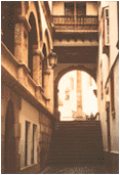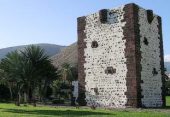|
 LA PALMA:
LA PALMA:
At present is the Province's second port by traffic of merchandises. It played an important role up to the past century trading with South America and the Antilles. It is also the port of call of many cruise ships along the whole year.
The capital Santa Cruz de La Palma, founded 500 years ago, is a perfect example of the harmonius blending of modern buildings and picturesque fishing villages. La Palma is an island with a long tradition of craftsmanship, ranging from extraordinary silk fabrics, embroidery and tapestry to woodwork, straw-weaving, wickerwork and earthenware.
La Palma is also a land abounding in excellent wines, such as the Malvasia, with a strength of caracter all of its own.
Close by the capital can be found the Sanctuary of the Virgen de Las Nieves, famed for its festival and the unique "Dance of the Dwarfs" , a truly evocative experience for the visitor.
The privileged climate and majestic beauty of the island of La Palma has given rise to the nickname "The Fair Island". The clear, limpid skies led to the International Scientific Community choosing this Island and Tenerife as the site for the two most important Astrophysics Observatories in the Northern Hemisphere.
The lush vegetation is a blend of vast palm groves and leafy pine forests, indigenous to the Canary Islands.
The sheer, rocky coastline, interspersed with beaches of black sand and volcanic landscapes, is a source of never-ending wonder. Discover La Caldera de Taburiente, a natural land crater, 28,000 meters in circumference and over 700 meters deep.
A natural enviroment which has bred unique plant and animal life.
Lovers of nature and peace will find their private paradise in La Palma.
 LA GOMERA:
LA GOMERA:
Is one of the most beautiful of the Canary Islands. The capital is San Sebastian , a city abounding in in historical and artistic monuments, such as the church of Asuncion de Gomera where Christopher Columbus prayed before setting off on his voyage to discover America.
The island of La Gomera is a land of contrasts. Leaving San Sebastian, you reach the Valley of Hermigua, a vast banana plantation, scattered with white farmhouses at the foot of "El Cedro" mountain. From the lofty peak of Garajonay, a panorama of the whole island opens up,
with deep valleys carpeted with the trees of an extraordinary rain forest: the National Park of Garajonay.
The park protects a virgin forest, resplendent with luxuriant vegetation of unimaginable splendour.
The valley of Gran Rey is the most popular tourist spot of the island, with long beaches of black, volcanic sand and wide range of of restaurants inviting visitors to enjoy the best of Canary Islands gastronomy.
 GRAN CANARIA:
GRAN CANARIA:
The South offers warm, sheltered waters friging the attractive golden sand beaches of San Agustin, El Ingles and Maspalomas and charming, tiny harbours of fishing villages sucha as Puerto de Mogan, Puerto Rico and Pasito Blanco.
An essential visit is also Palmitos Park, an extravagant garden of birds, orchids and a dazzling array of flowers.
The green farming area to the north and centre of the island awaits you with its pretty country villages, proudly displaying their churches, local markets and craftwork. Discover Arucas, Teror, San Mateo... Tejeda, in the centre of the Islan, among mountains and pine forests,
is the site of the rock formations of Roque Nublo and the Roque Bentayga, the giant symbols of veneration for the first island inhaitants and described as having the form of a petrified storm.
In Las Palmas de Gran Canaria, the capital of the island and the largest city of the archipielago, your vessel can be moored in the heart of the city's tourist centre. Disembark in the newly restored Santa Catalina wharf and a simple stroll will take you to the beach of Las Canteras, or the shopping centre offering a vast range of goods at very attractive prices.
The city has a very beautiful quarter, Vegueta and Triana, where you can admire the narrow cobbled streets, visit the House of Columbus or the cathedral and savour the colonial atmosphere of its Hispanic-American history.
FUERTEVENTURA:
Stretches over the Atlantic like a magic desert, circled by warm, white sands and bathed by a sea of the deepest turquoise in the Archipielago. Puerto del Rosario is its capital, situated halfway between the north and the south of the island.
On the opposite coast is Betancuria, a shrine of history whose name was given by its founder, Jean de Bethencourt, and the birthplace of the first european settlement in the Canary Islands.
Santa Maria de Betancuria, its Norman Gothic style church, the Chapel of San Diego and the Convent Church, the Museum of Sacred Art and History Museum, togetherform the most significant historic site of the island.
The route of the Windmills winds through the central plains of the island, leading to the white-washed hamlet of Antigua.
The chromatic splendour of the landscape is dazzling as we encounter the Nature Park of Las Dunas de corralejo, from wich point can be seen the Isla de Lobos and the straits of Bocayna which separate it from Lanzarote.
On reaching La Oliva, the capital of the north, do not fail to visit the House of the Colonels , a colonial style building with an austere, imposing facade, which "has as many doors and windows as days in the year".
The beaches of the south breathe an air of peace and tranquility. Relax on the white sand beaches of Jandia.
LANZAROTE:
With its 300 volcanoes this mythical island has been scorched by fire, with lava trails forging a strikingly unique landscape. The extraordinary nature of the land has been classified by UNESCO as a world Biosphere reserve.
The landscape is unnerving. If you want to visit the the National Park of Timanfaya, you can choose to do so on the hump of a camel, whilst the capricious and alien terrain will lead you to believe tha you have suddenly reached another planet.
Each corner of the island opens up vistas where nature itself has created wonders of architecture, such as Los Jameos del Agua, giant volcanic bubbles encircling a salt-water lake breeding a unique species of crabs.
Similar sensations will be experienced on visiting the Cave of Los Verdes, formations which will recall mythical histories from remote time past, or the wonder of the panorama from the Mirador del Rio, the Vines of La Geria, the cactus garden, the Monument to the peasant and the many museums and castles of the island.
The buildings created by the island's inhabitants also lend to the singular nature of this landscape. Cesar Manrique, painter, sculptor, and architect is the most renowned figure in this mmeting between nature and the art of the Man.
|

